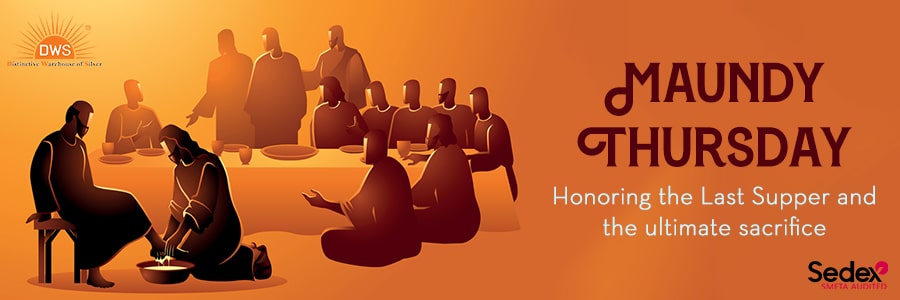- Written By Team DWS
- Festivals
- March 28, 2024
Maundy Thursday: Understanding the Meaning and Significance
Maundy Thursday, the day before Good Friday, holds great importance in Christianity as it marks the Last Supper shared by Jesus and his disciples. It falls on the Thursday before Easter Sunday and marks the beginning of the Easter Triduum, the three-day period that includes Good Friday and Easter Sunday. In this blog post, we will delve into the meaning and significance of Maundy Thursday and explore its relevance in Christian faith.

The Last Supper: A Symbolic Meal
One of the central events of Maundy Thursday is the Last Supper, where Jesus shared a meal with his disciples before his crucifixion. During this meal, Jesus washed the feet of his disciples, demonstrating humility and service. He also instituted the sacrament of the Holy Eucharist, instructing his followers to remember him through the bread and wine, which symbolize his body and blood.
The Last Supper is a powerful symbol of love, forgiveness, and sacrifice. Jesus' act of washing the disciples' feet was a gesture of humility and servanthood, which is a core value in Christian teachings. By sharing the bread and wine with his disciples, Jesus foreshadowed his sacrifice on the cross and the redemption of humanity through his death and resurrection.
The Mandate of Love
The term "Maundy" comes from the Latin word "mandatum," which means commandment. On Maundy Thursday, Christians commemorate Jesus' commandment to love one another as he has loved them. This mandate of love is a central theme in Jesus' teachings and is embodied in his actions during the Last Supper.
Jesus' mandate of love extends beyond mere words; it is a call to action. By washing his disciples' feet and sharing a meal with them, Jesus demonstrated the importance of serving others, showing compassion, and fostering unity among believers. The act of washing feet was traditionally performed by servants, but Jesus inverted social norms by assuming the role of a servant and challenging his disciples to do the same.
The significance of the mandate of love on Maundy Thursday is a reminder for Christians to practice selfless love, kindness, and empathy towards others. It emphasizes the importance of humility, service, and forgiveness in relationships with others, mirroring the example set by Jesus during the Last Supper.
The Institution of the Eucharist
Another crucial aspect of Maundy Thursday is the institution of the Eucharist, also known as the Lord's Supper or Holy Communion. During the Last Supper, Jesus broke bread and shared wine with his disciples, instructing them to partake in remembrance of him. This act symbolizes the unity of believers with Christ and with one another through the sharing of a common meal.
The Eucharist holds profound spiritual significance for Christians, as it represents the body and blood of Christ given for the redemption of sins. By participating in the Eucharist, believers are invited to commune with Christ spiritually and experience the transformative power of his sacrifice. It serves as a tangible reminder of God's presence and love, nourishing believers' faith and fostering spiritual growth.
The Eucharist also serves as a symbol of unity within the Christian community. Through the act of sharing the bread and wine, believers are reminded of their common faith in Christ and their connection to one another as members of the body of Christ. This sense of unity is a foundational aspect of Christian identity and reinforces the importance of fellowship and mutual support among believers.
In conclusion, Maundy Thursday holds deep significance in the Christian faith as a day of remembrance, reflection, and renewal. By commemorating the Last Supper, the mandate of love, and the institution of the Eucharist, Christians are called to emulate Jesus' example of humility, service, and sacrificial love. It is a time to reflect on the core values of the Christian faith and to recommit oneself to living out the message of love and redemption embodied in the events of Maundy Thursday. As we observe this holy day, may we be inspired to follow the example of Christ and strive to embody his teachings in our daily lives.

Maundy Thursday FAQs:
1. What is Maundy Thursday and why is it celebrated?
Maundy Thursday is the Christian holiday that falls on the Thursday before Easter Sunday. It commemorates the Last Supper of Jesus Christ with his disciples, as well as the institution of the Eucharist. The word "Maundy" comes from the Latin word "mandatum," meaning commandment, in reference to Jesus' commandment to love one another as he loved them (John 13:34).
It is celebrated by many Christian denominations through special church services, often including the washing of feet as a symbol of humility and service. Some churches also participate in the tradition of the Eucharist or communion during the service. The day is seen as a time to reflect on the sacrifice of Jesus and his teachings on love and service to others.
2. What is the meaning behind the name "Maundy Thursday"?
Maundy Thursday is the Christian holy day that commemorates the Last Supper of Jesus Christ with his apostles before his crucifixion. The term "Maundy" is believed to have originated from the Latin word "mandatum," meaning commandment, referring to the commandment Jesus gave to his disciples to love one another as he had loved them. This is symbolized through Jesus washing the feet of his disciples as an act of humility and service. The name Maundy Thursday therefore reflects the themes of love, humility, and service associated with this day in Christian tradition.
3. When is Maundy Thursday celebrated and how is it determined?
Maundy Thursday is celebrated on the Thursday before Easter Sunday. It is determined by the date of Easter, which is a moveable feast that changes each year. Easter is calculated as the first Sunday following the full moon that occurs on or after the spring equinox. Maundy Thursday typically falls between March 19 and April 22.
4. What is the historical significance of Maundy Thursday in Christianity?
Maundy Thursday holds great historical significance in Christianity as it commemorates the Last Supper, which was the final meal Jesus shared with his disciples before his crucifixion. During this meal, Jesus washed the feet of his disciples as a gesture of humility and service, and he also instituted the Eucharist, or Communion, where he shared bread and wine with his disciples as symbols of his body and blood.
Additionally, Maundy Thursday marks the beginning of the Easter Triduum, which is a period of three days that includes Good Friday (the day of Jesus' crucifixion) and Holy Saturday (the day of Jesus' tomb). This period is considered the most sacred time in the Christian calendar, as it commemorates the events leading up to Jesus' death and resurrection.
Overall, Maundy Thursday is a significant day in Christianity as it is a time to remember and reflect on the sacrifice Jesus made for the salvation of humanity, as well as a time to practice humility, service, and the importance of the Eucharist in the Christian faith.
5. What events from the Bible are associated with Maundy Thursday?
Maundy Thursday, also known as Holy Thursday, is the day in the Christian liturgical calendar that commemorates the Last Supper of Jesus Christ with his disciples. It is also the day when Jesus washed the feet of his disciples and gave them a new commandment to love one another.
Some key events associated with Maundy Thursday from the Bible include:
- The Last Supper: This event is described in all four Gospels (Matthew 26:17-30; Mark 14:12-26; Luke 22:14-38; John 13:1-30). Jesus shared a meal with his disciples, during which he foretold his betrayal by Judas, instituted the sacrament of the Eucharist, and gave them the commandment to love one another as he had loved them.
- Jesus washing the feet of his disciples: In the Gospel of John (13:1-17), it is recorded that Jesus humbly washed the feet of his disciples as an example of loving service and humility. He told them that they should do the same for one another.
- The betrayal of Judas Iscariot: After the Last Supper, Judas Iscariot betrayed Jesus to the religious authorities for thirty pieces of silver. This betrayal ultimately led to Jesus' arrest, trial, and crucifixion.
- The Agony in the Garden of Gethsemane: Following the Last Supper, Jesus went to the Garden of Gethsemane to pray, where he experienced great anguish and sorrow over the events that were about to unfold. It is in this garden that Jesus prayed to God, "Not my will, but yours be done."
These events are all significant in the background of Maundy Thursday and are remembered and commemorated by Christians around the world on this day.
6. Why is Maundy Thursday considered an important day in the Holy Week calendar?
Maundy Thursday is considered an important day in the Holy Week calendar because it commemorates several key events in Christian theology.
One of the most significant events commemorated on Maundy Thursday is the Last Supper, where Jesus shared a final meal with his disciples before his crucifixion. This event is considered the institution of the Eucharist, or Holy Communion, which is a central sacrament in many Christian traditions.
Additionally, Maundy Thursday also marks the occasion when Jesus washed the feet of his disciples, teaching them the importance of humility and service. This act symbolizes the selfless love and sacrifice that Jesus demonstrated throughout his ministry.
Overall, Maundy Thursday serves as a reminder of the central themes of Christian faith, including sacrifice, servanthood, and the importance of communion with God and others.
7. What are some traditional customs and practices observed on Maundy Thursday?
- Washing of the feet: In some Christian traditions, people may participate in a ceremony where the feet of others are washed to symbolize humility and service.
- Celebration of the Last Supper: Many Christians observe Maundy Thursday by attending a special church service focused on the Last Supper, where Jesus shared bread and wine with his disciples.
- Eucharistic adoration: Some churches hold extended periods of prayer and reflection in front of the Blessed Sacrament, which is believed to be the body of Christ.
- Confession and repentance: Maundy Thursday is seen as a time for reflection on one's sins and seeking forgiveness through confession and repentance.
- Fasting and abstinence: Some people may choose to fast or abstain from meat on Maundy Thursday as a form of penance and preparation for the Easter season.
- Visiting seven churches: In some cultures, it is a tradition to visit seven different churches on Maundy Thursday to pray and reflect on the events of Jesus' crucifixion.
- Charity and service: Maundy Thursday is also a time for acts of charity and service to others, in keeping with Jesus' example of love and compassion towards all people.
8. How do different Christian denominations observe Maundy Thursday?
Different Christian denominations observe Maundy Thursday in various ways, but some common practices include:
- Roman Catholic Church: The Roman Catholic Church typically holds a Mass on Maundy Thursday, during which the priest washes the feet of 12 people in imitation of Jesus washing the feet of his disciples. The Eucharist is also celebrated, and the members of the congregation may engage in the ritual of adoration of the Blessed Sacrament.
- Protestant Churches: Many Protestant denominations also hold Maundy Thursday services, which may include foot washing ceremonies, the celebration of the Lord's Supper, and the reading of the story of Jesus' Last Supper with his disciples. Some Protestant churches may also hold Tenebrae services, which involve the gradual extinguishing of candles to symbolize the approaching darkness of Jesus' crucifixion.
- Eastern Orthodox Church: In the Eastern Orthodox Church, Maundy Thursday is known as Great and Holy Thursday. The evening service, known as the Matins of the Holy and Saving Passion of Our Lord, includes the reading of the twelve Gospel passages that recount the events of Jesus' Passion. The Liturgy of Saint Basil the Great is also celebrated on this day.
- Anglican/Episcopal Church: In Anglican and Episcopal churches, Maundy Thursday services may include foot washing ceremonies, the celebration of the Eucharist, and the stripping of the altar. The liturgical color for Maundy Thursday is typically either red or white.
Overall, Maundy Thursday is a solemn and reflective day in the Christian calendar, and different denominations observe it with a focus on the Last Supper, Jesus' selfless act of service, and the approaching events of Good Friday and Easter.
9. What is the symbolism behind the washing of the feet on Maundy Thursday?
The washing of the feet on Maundy Thursday symbolizes humility, service, and the importance of mutual care and support within the Christian community. It is modeled after the actions of Jesus Christ, who washed the feet of his disciples as a demonstration of servant leadership.
By participating in the washing of the feet ceremony, Christians are called to imitate Jesus's example of humility and selflessness in serving one another. It serves as a reminder to put the needs of others before our own and to approach relationships with a spirit of love and sacrifice.
Additionally, the act of washing another person's feet represents a willingness to care for and support one another in times of need. It symbolizes the importance of compassion, empathy, and solidarity within the Christian community, fostering a sense of unity and mutual respect among believers.
10. How is the Last Supper commemorated on Maundy Thursday?
The Last Supper is commemorated on Maundy Thursday through various traditions and practices:
- Some Christian denominations hold a special church service on Maundy Thursday, where the Last Supper is reenacted, and communion is taken in remembrance of Jesus' last meal with his disciples.
- In some churches, a foot-washing ceremony is performed on Maundy Thursday to symbolize Jesus' act of humility and service towards his disciples.
- Many Christians also participate in a fast on Maundy Thursday as a way of reflecting on Jesus' sacrifice and suffering.
- Some traditions include the blessing and sharing of a special meal, such as bread and wine or a symbolic Passover meal, in remembrance of the Last Supper.
Overall, Maundy Thursday serves as a reminder of Jesus' final hours with his disciples before his crucifixion and is a time for reflection, prayer, and remembrance of the significance of the Last Supper in Christian faith.
11. What is the significance of the betrayal of Jesus by Judas on Maundy Thursday?
The betrayal of Jesus by Judas on Maundy Thursday holds significant symbolic and theological importance in Christian theology.
Firstly, the betrayal foreshadows Jesus' crucifixion and sacrifice, as it sets in motion the events that lead to Jesus being arrested, tried, and ultimately crucified. This act of betrayal by one of Jesus' own disciples highlights the theme of human sinfulness and the rejection of God's love and mercy.
Secondly, the betrayal serves as a reminder of the importance of loyalty and faithfulness in the Christian faith. Judas' betrayal is often contrasted with the loyalty and faithfulness of Jesus' other disciples, such as Peter, who later denies Jesus three times. The betrayal serves as a cautionary tale for believers to remain steadfast in their faith and devotion to God, even in the face of temptation or adversity.
Overall, the betrayal of Jesus by Judas on Maundy Thursday is a key event in the Christian narrative that underscores themes of sin, redemption, loyalty, and faithfulness. It serves as a reminder of the enduring significance of the Easter story and the ultimate sacrifice that Jesus made for the world.
12. How is Maundy Thursday linked to the events leading up to Good Friday and Easter Sunday?
Maundy Thursday is linked to the events leading up to Good Friday and Easter Sunday through the Last Supper, which is traditionally believed to have been held on this day. The Last Supper was the final meal that Jesus shared with his disciples before his crucifixion, and it included the institution of the Eucharist and the washing of the disciples' feet by Jesus. These events symbolize Jesus' sacrifice and the act of service and humility, which are central themes of the Christian faith.
Following the Last Supper, Jesus was betrayed by Judas Iscariot, arrested, and ultimately crucified on Good Friday. His death on the cross is seen as the ultimate act of love and redemption, leading to the forgiveness of sins and the promise of eternal life for believers.
Easter Sunday, which celebrates the resurrection of Jesus from the dead, follows Good Friday. The events of Maundy Thursday, Good Friday, and Easter Sunday together form the central narrative of the Christian faith, emphasizing themes of sacrifice, redemption, and new life.
13. What are some of the key themes associated with Maundy Thursday in Christian theology?
- The Last Supper: Maundy Thursday commemorates Jesus' Last Supper with his disciples, during which he instituted the sacrament of the Eucharist.
- Sacrifice: Maundy Thursday is also associated with Jesus' sacrifice on the cross, as he knew he was soon to be arrested and crucified.
- Service: The name "Maundy" is derived from the Latin word mandatum, meaning commandment. It refers to the commandment Jesus gave to his disciples to love one another and to serve one another, as he demonstrated by washing his disciples' feet.
- Remembrance: Maundy Thursday is a time for Christians to remember and reflect on Jesus' actions and teachings during his Last Supper and his time with his disciples.
- Preparation: Maundy Thursday is often a time for Christians to prepare themselves spiritually for Good Friday, when Jesus was crucified, and Easter Sunday, when he rose from the dead.
14. How is Maundy Thursday observed in different parts of the world?
Maundy Thursday is observed differently in various parts of the world, but some common observances include:
- Washing of the feet: In many Christian churches, including the Roman Catholic Church, it is traditional to hold a foot-washing ceremony on Maundy Thursday to symbolize Jesus' act of humility when he washed his disciples' feet.
- Communion: Many churches also hold a special communion service on Maundy Thursday to remember the Last Supper.
- Processions: In some countries, Maundy Thursday processions are held to commemorate the events of Jesus' arrest and crucifixion. These processions may include participants carrying crosses or reenacting scenes from the Passion of Christ.
- Church services: Many churches hold special worship services on Maundy Thursday, often focused on themes of repentance, forgiveness, and service.
- Easter egg preparation: In some countries, Maundy Thursday is also a day for preparing Easter eggs, which are then decorated and used as part of Easter celebrations.
Overall, Maundy Thursday is observed in a variety of ways around the world, but the common thread is a focus on worship, reflection, and preparation for the events of Good Friday and Easter Sunday.
15. What are some ways for individuals to observe and reflect on the meaning of Maundy Thursday in their own spiritual practice?
- Attend a Maundy Thursday service: Many churches offer special services on Maundy Thursday that include foot washing, communion, and readings from the Bible. Attending a service can help you reflect on the meaning of the day and its significance in the Christian faith.
- Participate in a foot washing ceremony: Foot washing is a traditional ritual that symbolizes humility, service, and love. You can participate in a foot washing ceremony at a church or even with a small group of friends or family members to reflect on the act of serving others as Jesus did.
- Read and meditate on the biblical passages related to Maundy Thursday: The Gospels of Matthew, Mark, Luke, and John all include accounts of Jesus's Last Supper with his disciples on Maundy Thursday. Reading and meditating on these passages can help you gain a deeper understanding of the significance of the day.
- Practice acts of service and love: In addition to reflecting on the events of Maundy Thursday, you can also put its teachings into practice by performing acts of service and love for others. This could be as simple as volunteering at a local charity, helping a neighbor in need, or reaching out to someone who is lonely or struggling.
- Spend time in prayer and reflection: Take some time on Maundy Thursday to pray, meditate, and reflect on the meaning of the day in your own spiritual journey. Consider how you can embody the teachings of Jesus in your own life and strive to follow his example of love, humility, and service.
Popular on Blogs

Black Tourmaline: Meaning, Healing Properties, Fascinating Facts, Powerful Attributes, Versatile Uses, and Beyond
September 05, 2023 / BY Team DWS
Black Tourmaline, also known as Schorl, is a highly revered crystal with incredible metaphysical properties. It derives its name from the Dutch word "turamali," meaning "stone with ..

Carnelian Stone: Meaning, Healing Properties, Power, Facts, Color, Uses and More
December 26, 2023 / BY Team DWS
Carnelian is a vibrant and captivating gemstone that holds a plethora of meanings, healing properties, and powers. Its warm and fiery energy makes it a popular choice among crystal ..

Citrine: Exploring its Meaning, Healing Properties, Fascinating Facts, Powers, Versatile Uses, and Much More
November 18, 2023 / BY Team DWS
Citrine, with its warm golden hues, has captured the attention and imagination of people for centuries. This beautiful gemstone, commonly associated with wealth and prosperity, hol ..

Black Onyx: Unveiling the Meaning, Healing Properties, Fascinating Facts, Powerful Attributes, Versatile Uses, and Beyond
July 25, 2023 / BY Team DWS
Black Onyx, a striking gemstone admired for its deep black hue and elegant appearance, has captivated people for centuries. In this comprehensive guide, we will delve into the mean ..

Unveiling the Mysteries of Turquoise Stone: Exploring its Meaning, Healing Properties, Power, Facts, Color, Uses, and More
December 05, 2023 / BY Team DWS
Turquoise, with its captivating blue-green hue, has been adorning jewelry and artifacts for centuries. This striking stone has a rich history, rich symbolism, and a plethora of int ..

The History Behind The Popularity of Red Agate
December 23, 2022 / BY Team DWS
An Agate is a type of magma rock that takes many years till it is washed out naturally into the water. And that is the reason this stone has elements of water. This beautiful stone ..

Plan a Perfect Valentine's Week with Our Valentine Week List 2025
January 22, 2024 / BY Team DWS
Valentine's Day is undoubtedly the most romantic day of the year, but we believe that one day is just not enough to express your love and make your partner feel special. That's why ..

Bloodstone: Unveiling the Meaning, Healing Properties, Facts, Powers, Uses, and More
August 21, 2023 / BY Team DWS
Bloodstone, with its captivating deep green color with specks of red, is a mesmerizing gemstone that has fascinated civilizations for centuries. It possesses unique healing propert ..


